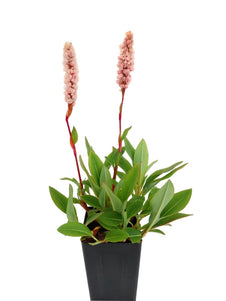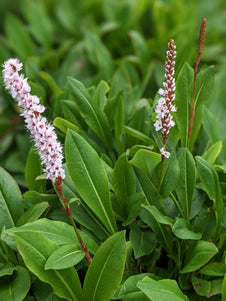



Bistort
Bistort

- Low stock - 12 items left
- Inventory on the way

Usually available: November to March
Life cycle: Perennial
Height: 50 - 75cm
Position: Sun / part shade
Soil preference: Moist / well drained
This is how we pack and send your Herb Plants to all states except TAS & WA
You will receive
- 1 Bistort Herb Plant in a 50 X 75mm tube - General growing instructions
All of our Herb Plants are grown organically with certified organic potting mixes and fertilizers
Botanical Name: Bistorta officinalis
Bistort is a tough perennial plant, growing to 75cm high by 90cm wide in ideal conditions. It has thin stems, with oblong or triangular, ovate bright blue-green leaves, alternatively described as lance shaped and extending up to 15cm or more. The pink summer flowers are reminiscent of thin bottlebrush flowers and extend up to 12 cm. Bistort is often identified from a distance, by the many stalks of pink flowers found within grassy clearings, in the northern hemisphere woods. The root is dark brown to black on the outside and generally shaped into an ‘S’ shape. Cut into it to see the rich red colour resulting from the high tannin content.
The Latin words ‘bis’ means ‘twice’ and ‘torta’ means ‘twisted’, a reference to the twisted and creeping nature of the bistort plant. An old local name with a literal translation of the Latin is ‘twice writhen’. Bistort is also called adderwort, snake weed, snakeroot, Easter giant, patience dock and red legs. Further reference to the plant can be found using terms such as serpentaria, columbrina, dracunculus and even serpentary dragonwort. The old medieval classification of bistort was Persicaria bistorta, which referred to the peach (Persica) shaped leaves. Polygonum bistortoides is found in North America and is very closely related to bistort.
Bistort is found growing naturally in the northern hemisphere, including Northern England, Southern Scotland, Northern Ireland, Northern Europe, Siberia, Japan and Western Asia through to the Himalayas. With highly decorative flowers, it is a natural butterfly and bee attractant and is most commonly grown as an ornamental garden and border plant. Prior to the 20th century, bistort was cultivated as both a culinary and medicinal plant.
Growing Conditions
Bistort is happy to grow in a wide variety of soil types and the ground does not need to be well drained. It does very well in damp areas near larger watercourses, ponds, or the edge of small streams, but may need to be controlled in these areas. If left to its own devices, it will spread and form a nice ground cover. As long as water is supplied the plant will tolerate warm conditions, but its origins in the northern hemisphere allow it to tolerate up to minus 25 C.
It will grow in full sun to part shade, but if it is very warm or hot in your garden choose a semi-shade position. When water is scarce the plant will not flower very well, so moist soil is best. If it is too dry the plant will go dormant for a period. The clusters of pink flowers appear during spring and summer, or November to March in Australia. The seeds ripen from February to April. The roots may be dug up in autumn for drying (cut long roots in half) or immediate use. Leaves are best picked and used while young.
To grow bistort you can sow seed in spring when temperatures are 18-24 C, direct in the ground or in trays if you are in cold regions. The seedlings may be potted up and planted in the garden once it is warm enough in your area. The seedlings may take from 21-60 days to appear, but otherwise growing bistort from seed is quite easy. In warmer areas where there is no real cool season, it may be helpful to mimic the seasons by placing seeds in the fridge for a period. Mature clumps may be divided to be planted elsewhere in the garden or simply to contain growth.
Culinary Uses
Bistort does have some tradition as use for food, with Russia, Iceland and Siberia in particular using the plant as a food source during famine. However, it is not one of the main reasons for growing the plant. All parts of the plant are edible and may be used either raw of cooked. The rhizome is known to have high starch content and is said to be very tasty and nutritious. It was used during periods of famine to provide a high calorie meal when other food was scarce.
The reddish coloured roots may be treated like potatoes and used in soups, stews or roasted. Alternatively, they may be dried into a powder and used to make bread flour. Before roasting the roots may be steeped in water to reduce the tannin content. The leaves taste bitter, young leaves less so, and they may be used as a spinach replacement. Bistort is a main ingredient in ‘bitter Lenten pudding’, made for Easter in Northern England.
Medicinal Uses
Much of the traditional medicinal benefit from bistort was derived from the high tannic acid content, combined with the presence of gallic acid, gums and starches. Bistort is known to be strongly astringent, which helps bodily tissues contract and reduce mucous flow. Bistort may also assist with some digestion problems, such as diarrhoea; in reducing mouth irritation by reducing swelling; as a demulcent by softening and lubricating bodily tissues; act as a mild diuretic; in healing of wounds when applied directly; and as has a styptic action which may help reduce internal bleeding. However, there have not been any clinical trials to explore the effectiveness of bistort.
Traditionally, boiling the roots made a wine, which was then used for curing dysentery and diarrhoea, impeding vomiting, controlling excessive menstruation, and curing inflammation of the mouth and throat. During Shakespeare’s time, bistort was used to treat nasal polyps. It was also used extensively as a mouthwash and had a great reputation as being useful for ‘fastening loose teeth’.
Bistort also contains oxalic acid, which is not a direct toxin. However, when consumed in higher quantities it binds sufficient minerals and nutrients to render them unavailable to the body. This results in mineral deficiencies and can cause significant problems. Cooking the plant parts reduces the oxalic acid content, similar to the need to cook sorrel and rhubarb.
The tannins in bistort may absorb and reduce the effectiveness of some medications by binding them while in the stomach. Take medications at least one hour prior to consuming bistort. Consumption of bistort may aggravate rheumatism, gout, arthritis and kidney stones.
All information provided on this website is for informational purposes only. Please seek professional advice before commencing any treatment.





